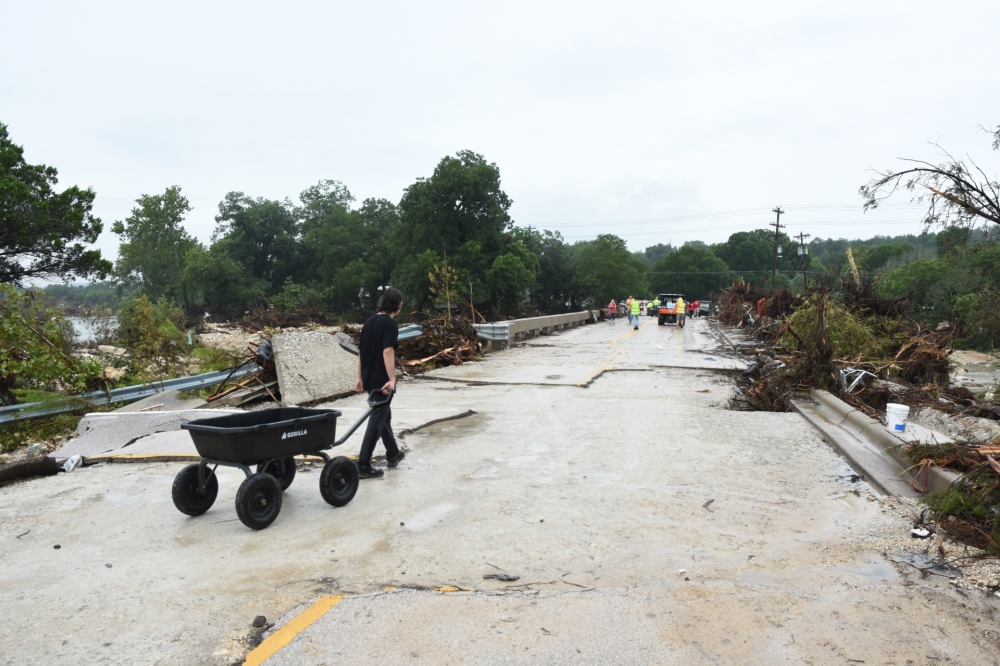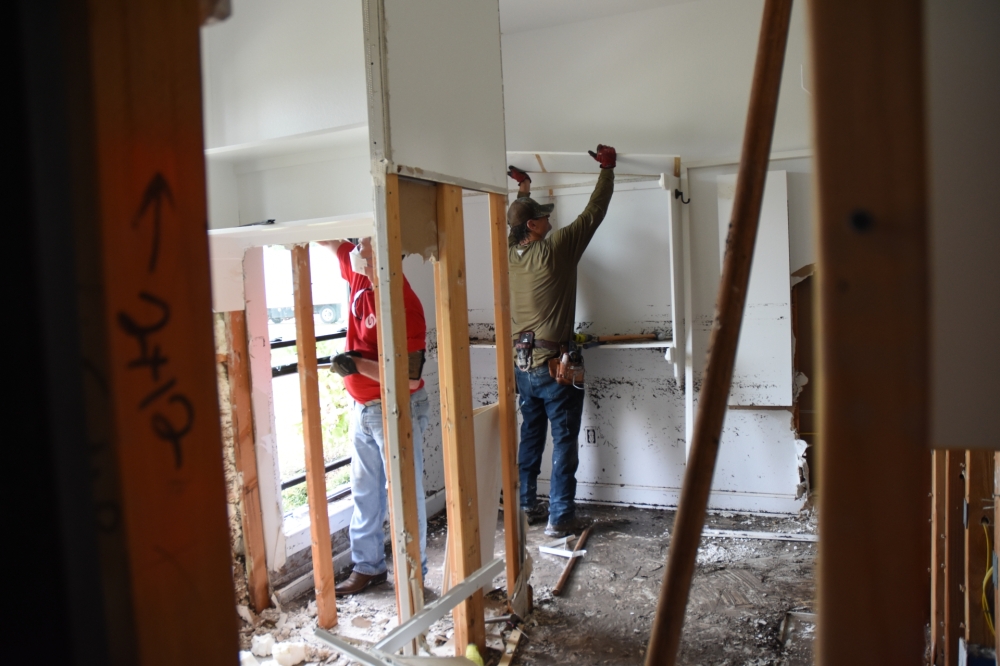“I understand that part of your job is managing liability, but when somebody's falling off a cliff, you're not looking for an indemnification agreement before you reach out and grab their hand,” Sandy Creek resident John Tichi said.
A week later, on July 22, Travis County emergency services officials shared updates on the county’s ongoing recovery efforts and the transition to longer-term support in the affected area.
“I recognize that there are community members still struggling to piece their lives back together. No matter how long takes, Travis County will be there to help,” Travis County Judge Andy Brown said in a statement.
What residents are saying
Flooding severely damaged or completely washed away several roads in the area. Among them was the Big Sandy Drive Bridge—the sole entry and exit point for a neighborhood of around 385 residents outside of Leander.
With the bridge impassable to vehicles, residents were trapped in their devastated community for nine days.
“We were left feeling like we were in a prison camp,” Tichi told commissioners.
Those living in the community were forced to travel on foot, carrying food and essential supplies in and out of the neighborhood.

To reach parked vehicles or aid stations, families had to walk down Round Mountain Road, a narrow, curving roadway with no shoulders, sidewalks or lighting. Leander ISD school buses are not even permitted to stop along it, Tonia Tichi said.
“On more than one occasion, people were throwing themselves into the ditches, into the mud, to avoid an oncoming, speeding car. There was zero traffic control, zero cones, zero police presence anywhere,” she said.
Tonia Tichi added that younger residents were able to make the walk, but that the neighborhood had many older residents that could not. The Tichis themselves live nearly a mile from the bridge.
County response
As of July 22, all roadways previously closed due to flooding are open, except the second crossing of Cow Creek Road just north of RM 1431, according to a county news release.
Working with local landowners, Travis County installed a temporary low-water crossing alongside the damaged Sandy Creek Bridge. The crossing now allows two-way traffic through the area.
The new crossing has allowed for larger debris removal vehicles to enter the community. The county began picking up flood debris from the affected areas July 14.
To date, the county-contracted crews have removed 13,324 cubic yards of debris, averaging roughly 3,500 cubic yards a day, according to county officials. For context, that totals more than four Olympic swimming pools worth of debris—one Olympic swimming pool holds roughly 3,300 cubic yards.
To increase efficiency, the debris removal team is also adding another truck and moving the temporary debris management site closer to Sandy Creek this week.
Additionally, a new 10-foot pedestrian path has been constructed along Round Mountain Road from Big Sandy Road to the Round Mountain Baptist Church triage station. The pathway features lighting at night and is marked by construction cones, which will be replaced and upgrades with traffic water barriers.
The Cow Creek Road water crossing is being handled by the Texas Department of Transportation, which announced July 18 that the reconstruction of the Cow Creek Bridge is targeted for completion by September.
Commissioners approved an additional $3 million in emergency funding—on top of an initial $4 million—to support more permanent road and bridge repairs in the area.
Recovery efforts
As search and rescue efforts have concluded, a total of 10 deaths have been confirmed.
County Health and Human Services, in conjunction with Austin Public Health, have served over 230 individuals at the Danielson Middle School recovery site, County Executive Pilar Sanchez told commissioners.
Sanchez emphasized that the city of Leander Emergency Services played a key role in helping the county establish its recovery site. She also noted that school staff have been present on-site, providing care for children while parents focused on recovery efforts.
Health professionals have been conducting wellness checks throughout the community, prioritizing households identified as most vulnerable. They are also monitoring and working to prevent cases of heat stroke.
Additionally, the health department continues to monitor mosquito activity and disease risk. Mosquito repellant dunks are available to residents.
As recovery efforts shift to more long-term strategies, Health and Human Services will be relocating closer to Sandy Creek at the Round Mountain Baptist Church.
The county’s permitting office is also working to set up a satellite location near Sandy Creek.
Commissioners approved the waiver of fees for all permitting costs for those working to rebuild their homes in the impacted area, including development, permit and septic fees.
Flood plain manager Shawn Snyder said rough estimates show that around 200 people would be eligible for this waiver.
“We're not looking to make things worse for people. ... It allows them to come to us quicker and for us to get them hopefully back on their feet and running sooner,” Snyder said.
Snyder hopes that establishing a satellite permitting office will remove barriers and allow residents to obtain permits more efficiently.

As recovery efforts move from emergency response to long-term rebuilding, residents say clear communication, accessible resources and consistent support remain essential. Many, including the Tishis, have expressed concerns about safety conditions and the speed of aid in the weeks following the flood.
The county's public information officer Hector Nieto told Community Impact the emergency services department is able to use Warn Central Texas—an emergency alert system—to coordinate messages to individual cellphones specific to the impacted area.
He noted that the communication team has also been extremely active on social media and has printed flyers to pass around the community. The county has a website dedicated to recovery resources and updates, found here.
Officials say that while additional resources—such as permitting assistance, public health services and infrastructure repairs—are underway, the recovery process is expected to take time.
“This is not going to be a sprint, this is going to be a marathon,” Travis County Commissioner Jeff Travillion said.
H-E-B contributed the first donation of $100,000 to the Travis County-sponsored CARES recovery fund. The county, in partnership with the Central Texas Community Foundation, aims to raise $1 million to provide direct financial assistance to affected individuals and families.
For those looking to help, the county is asking for monetary donations or clean up volunteer assistance. Those interested in donations can find more information here, and for volunteer opportunities here.





